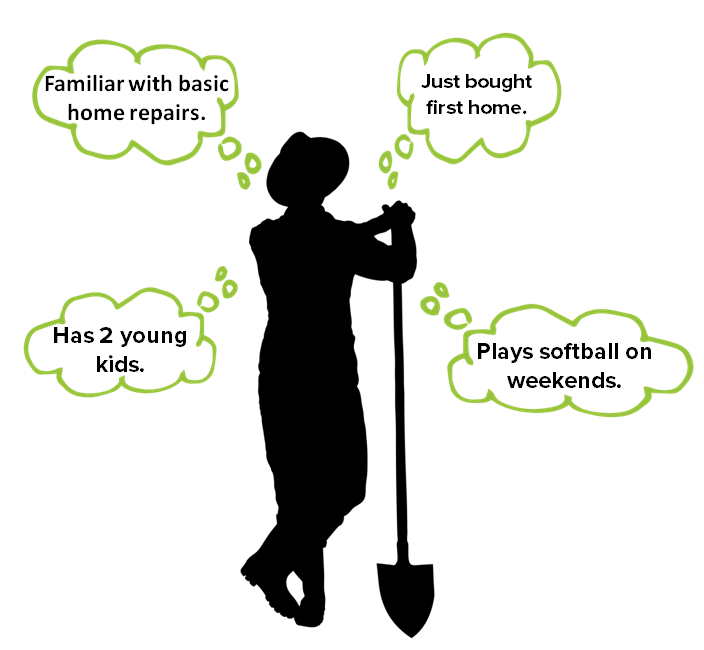More than 27 million pieces of content get posted online every single day. How can you be sure yours is being seen at all, let alone by the right people?
So often, we as marketers think that if we go after the demographics our products and services are most likely to appeal to, we’ll be able to capture the majority of our target audience. This will bring in some leads, of course. But is it the most effective?
As it turns out, when we rely solely on demographics we actually wind up missing more than 70 percent of potential buyers. Part of the problem is that people often think demographics and personas mean the same thing, but they don’t.
Demographics vs. Personas
Demographics include things like age, gender, race, and income bracket – pretty basic stuff. Personas, on the other hand, dig into the personality of the buyer, focusing on what makes them who they are, and what drives them to seek out the services or products you offer.
Take the home improvement industry – when you think of the typical person looking to remodel their kitchen, build a deck or spackle a wall, who do you see? I’d be willing to bet you’re picturing a man in his early 30s to late 50s. But this demographic is far from the only type looking to purchase tools and materials to do these sorts of projects.
 Actually, women are behind 45 percent of mobile searches for DIY home improvement projects. So if your content is targeted at men, you won’t see as many women visiting your blog, which means they’ll be less likely to come to you to make a purchase.
Actually, women are behind 45 percent of mobile searches for DIY home improvement projects. So if your content is targeted at men, you won’t see as many women visiting your blog, which means they’ll be less likely to come to you to make a purchase.
How do you take these groups, that fall outside the typical demographic, and incorporate them into your content strategy? You produce content that will appeal to all of them. The key here is to segment your efforts. Using this tactic, one of our clients saw 186% more blog revenue.
That’s not to say you need to have one page of your blog decked out in blues and another in pinks. In fact, steer clear of that option entirely, please.
What you do need to do is get inside the heads of your target buyers and discover their intent when they come to your blog.
- Are they researching ideas for future endeavors?
- Do they want step-by-step instructions to execute a project?
- Are they trying to decide which type of material to use?
Basing your strategy on buyer personas rather than trying to capture the attention of one generalized group will help to draw more people to your blog who are going to turn into customers.
3 ways to solve the persona puzzle

To cut through the noise, give the people what they want. Targeting your content strategy will make it easier for potential customers to find you among the millions of posts trying to grab their attention. The first step in achieving this goal is to know exactly whose eye you are trying to catch. When you have a clear picture of who your readers are and what they’re looking for, you will be able to decipher where they are in the buying process and create content that appeals to them.
First, your strategy should be segmented according to persona, but you also need to ensure you’re providing relevant information that benefits each persona as they travel through the sales funnel.
So, now the question becomes: Where do you find the details you need about your target audience to create solid, useful personas?
There are quite a few places to go to find out who your customers and prospects are, and some routes will lead to better results than others. Let’s take a closer look at your best options:
1. Talk to people
Interviews provide the most solid intel, in part because you can collect responses from your own staff, as well as from current and prospective clients. When you have such a wide breadth of data, it will reveal a clearer picture of the target audience.
A Cintell study found that 82.4 percent of B2B companies that exceeded their revenue goals in 2015 had performed qualitative interviews of customers and non-customers. Interviewing internal executive teams, salespeople and customer service employees ranked among the top five data sources for this group as well.
Questions interviews can answer:
- What are common hobbies and interests?
- What challenges do people face?
- What fears do they have?
- What are their personalities like?
- What is motivating them?
- What is the demographic information?
2. Analyze data
Looking at hard data can provide a wealth of information not revealed in the interviewing process. Explore the analytics from the content you already have as well as any information you glean from your CRM software.
Questions data can answer:
- How are buyers distributed in the sales process?
- What blogs have been the most successful?
- Are there any trends in content types or topics?
- Which content is more likely to lead to conversions?
3. Apply the information to create personas
All the data gathered in steps one and two can now be used to construct your buyer personas. You are not drafting a vague idea of who your audience is, but creating detailed descriptions of hypothetical people with names, jobs, hobbies, likes and dislikes, and more. Once you have these dossiers in place, you will be able to ask yourself, “What would Johnny X want to read today?” to keep your content focused.
When your content is designed with the persona at the forefront, you will stop attracting the wrong readers to your blog, and the traffic coming in will be made up of a much higher percentage of people who intend to buy.



